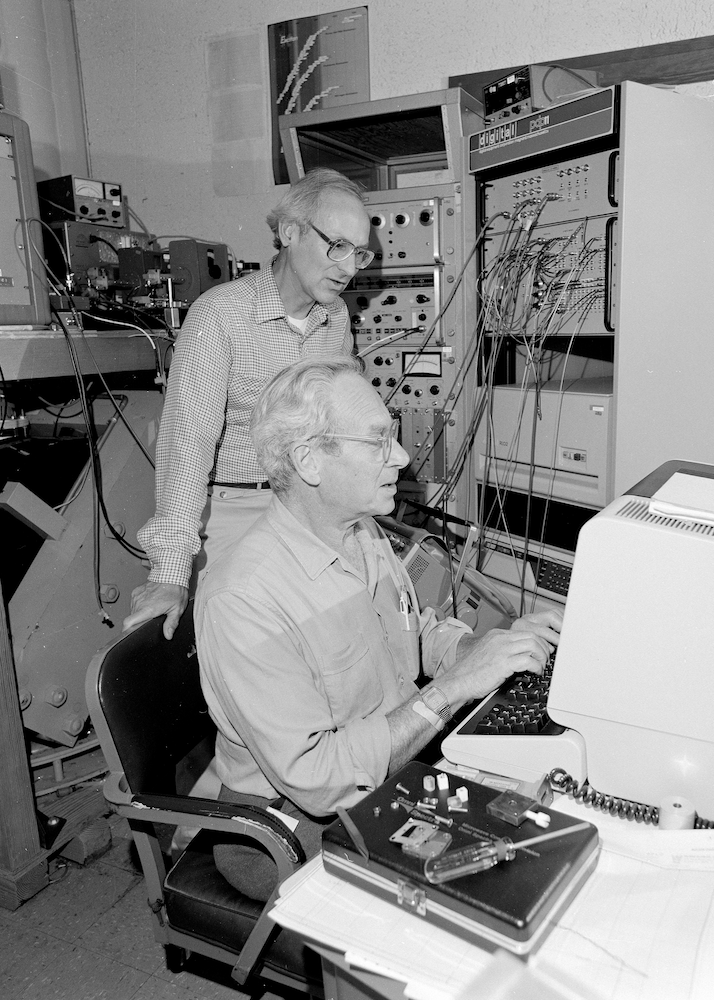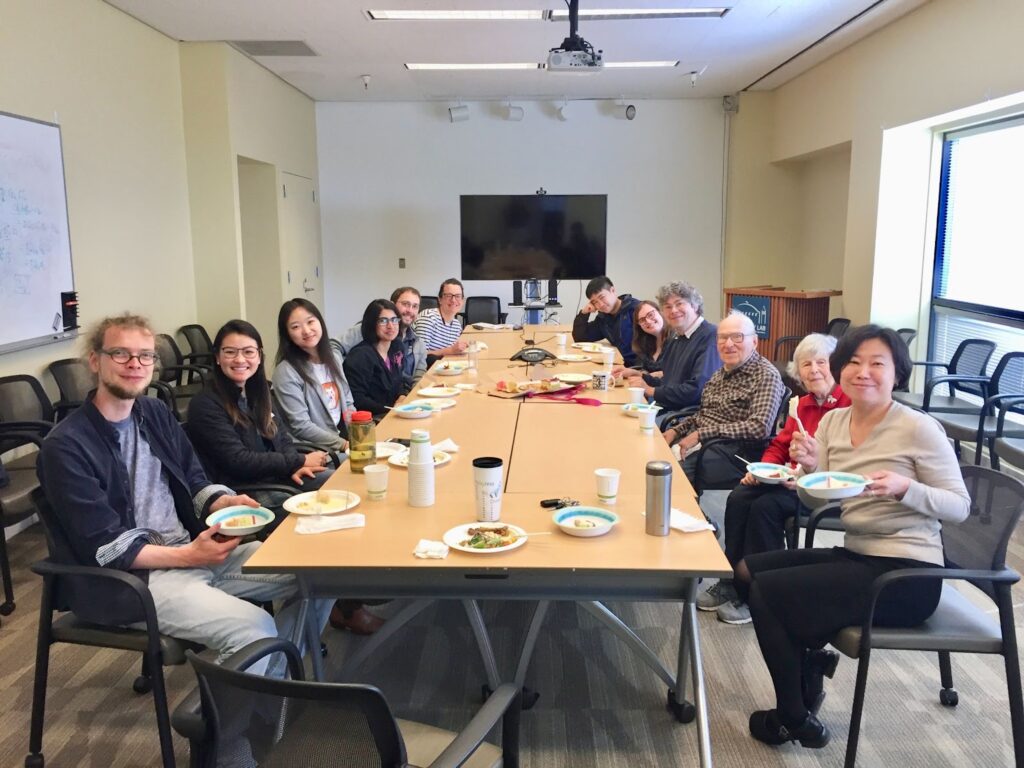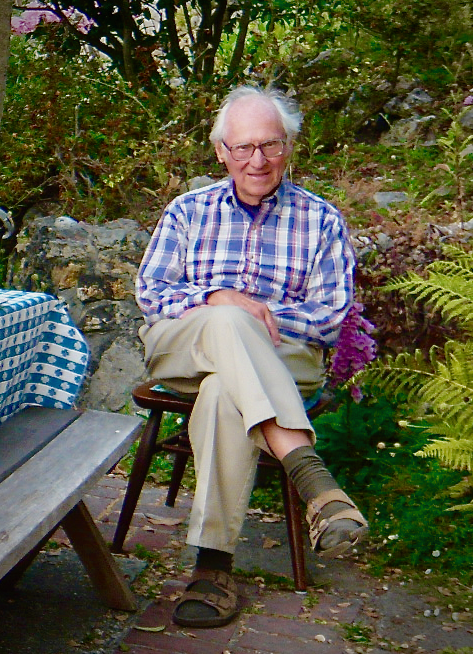As a young man, Kenneth Sauer joined Berkeley Lab four years after arriving in Berkeley for his postdoctoral position with famed chemist Melvin Calvin. By that time, he had accepted an assistant professorship in UC Berkeley’s Department of Chemistry to continue what would be his life’s scientific work on the intricate physical process of photosynthesis. He remained active for over 50 years and was, most recently, a professor emeritus of chemistry at UC Berkeley. Sauer died at the age of 91 following a brief illness on November 6, 2022.
Sauer was born in Cleveland, Ohio in 1931. After completing his undergraduate degree in chemistry at Oberlin College in 1953, he attended Harvard University. There, he studied gas-phase photochemistry with George Kistiakowsky, obtaining his PhD in 1958. He began a lifetime of immersive travel by relocating to Lebanon to teach at the American University of Beirut for two years.
In 1960, Sauer began his study of photosynthesis as a postdoctoral fellow with Calvin. Previously, Calvin had used carbon-14 to research carbon dioxide assimilation in plants, for which he received the Nobel Prize in Chemistry the following year.
Sauer joined the UC Berkeley faculty in the Department of Chemistry in 1963 to continue delving into the mechanism of photosynthesis. Sauer performed research in the Calvin Lab, a circular building erected in 1964 that is located between the law school and the business school on UC Berkeley’s campus. The building, which was part of Berkeley Lab, was designed by Calvin to encourage creative collaboration between groups arrayed around the center, which held shared equipment.
According to Vittal Yachandra, a senior staff scientist in the Molecular Biophysics and Integrated Bioimaging (MBIB) Division who was a postdoctoral researcher with Sauer, the building as designed by Calvin had no separate divisions for various principal investigators. “We all sat together, worked together… If you wanted to learn about other topics, they were just right around you,” he said. Yachandra pointed out that in the Calvin Lab, one could easily interact with scientists with diverse skills. When he arrived, there were already people applying molecular biology to photosynthesis research, which was a new set of techniques in the early 1980s. “In addition to his colleague Mel Klein, Ken really was one of the major people who encouraged this kind of interdisciplinary work,” he added.

Sauer was an active chemistry professor for nearly forty years. “Ken loved to teach and was good at it,” said Yachandra. Graham Fleming, MBIB senior faculty scientist, indicated that Sauer had a huge legacy of educating thousands of undergraduate students, in addition to his graduate students and postdoctoral researchers. “Ken took teaching very seriously,” Yachandra commented, and added that Fleming’s observation literally was true. “If you went camping or went to Point Reyes, you ran into someone he knew who took his courses.”
He recalled that Sauer was serious about teaching students how to speak in public and how to present their data. “He believed that just collecting data is not enough; you have to transmit it.” Yachandra frequently heard from Sauer’s students and postdocs. “One of the things they remember is how nervous they were to give a talk before him, and at the same time, how much they learned from him on how to present their data well both verbally and in written-form,” said Yachandra.
Sauer’s knowledge continues to be imparted through a textbook he co-wrote, first published in 1978, entitled Physical Chemistry: Principles and Applications in Biological Sciences. After five editions, it is a mainstay in many biophysics and physical chemistry courses today and a trusted resource for researchers.
Yachandra said he was impressed by Sauer’s lack of ego. “He was a humble person who never showed off or tried to impress people with how smart he was. It was intrinsic to his character,” he said. “Just about every famous person in photosynthesis at some point spent time in Ken’s lab. So we got to meet all those people and many were our peers who went on to become professors. And they’re all major people in the photosynthesis field now.”
The Sauer, Klein, and Calvin ethos of interdisciplinary research that produced these leading scientists was instilled in Yachandra starting forty years ago when he was a postdoc. He has continued this tradition with his MBIB colleagues, Junko Yano and Jan Kern, forming what they call the YYK Group. “Ken taught us not to pay attention to artificial divisions. The only thing that matters is to do good science,” Yachandra said.

After retiring from being a professor in 2001, Sauer remained active at the Lab as a senior affiliate in the YYK Group. Yachandra described their arrangement: “It was quite natural for him to stay as long as he wanted. We used him as a resource and it was mutually good.” Sauer could keep working and remained dedicated to science and teaching. Yachandra said, “His way to keep young was to talk to the young people here and be a kind of role model.”
Junko Yano, MBIB Interim Division Director, joined the Lab and began working with Yachandra that same year. She saw firsthand Sauer’s passion for teaching in a research setting. “It was relaxed and fun to interact and talk about science very actively,” she recalled.
Yano also observed that being retired gave Sauer more freedom to follow scientific pursuits in addition to their ongoing research on photosynthetic systems. Sauer was very interested in the origin of the manganese cluster, the catalytic center of the water oxidation complex in photosystem II. And he was particularly excited about the opportunities presented by genomic sequencing. “At some point he was also very interested in the cuneiform tablets in the UC Berkeley Anthropology Department and determining whether he could verify their authenticity using X-ray imaging. His research interests shifted quite a bit, but whatever he did, he was very passionate about it,“ Yano said.
MBIB staff scientist Jan Kern began working at the Lab with Yachandra and Yano as a postdoctoral researcher in 2008, but had met Sauer several years earlier while he was still a graduate student in Germany. “I remember meeting him at this international conference and at that time I didn’t know much,” Kern said, with a chuckle. “I was trying to understand all these big players in the field and Ken was one of them.” After reading papers spanning several decades from Sauer and his group, it was really nice for Kern to actually see the person behind the work. “I was surprised how approachable he was at that time for a PhD student,” Kern recalled.
Kern and Yano recollected that Sauer had many interests and activities outside the lab. Sauer and his wife, Margie, sang in local choirs until just a few years ago and he particularly enjoyed Baroque music. He loved food, which was a great excuse to get together with friends and connect. And gardening was one of Sauer’s pleasures. “Especially in the last years, when he was more at home and less mobile, he still appreciated working in the garden as much as possible,” Kern said. “Tending to the trees and bushes and plants, I think, was a nice counter activity to science as well.” Yano added, “His garden was our favorite place.”

Sauer’s backyard was a place to gather for the lab, which was like a huge family. His time spent traveling meant that he was comfortable with many cultures and could easily bring different people together. Often, fresh blueberries and raspberries were picked and enjoyed with ice cream. All major events in the life of the lab and its denizens––weddings, births, professional accomplishments––were celebrated there, with Sauer and his wife as the gracious hosts.
As a physical chemist, Sauer brought a lot of spectroscopy and very diverse interests to the study of photosynthesis. In his group, he created a huge family of people and the space to give scientists freedom to do their research. Though the group gatherings will now move to Yano’s backyard, Sauer’s tradition of excellence, mentorship, and community will continue.
Family and friends will gather to celebrate the life of Ken Sauer on Tuesday, July 18, from 2 to 5 PM, with the program beginning at 3 PM, in the Heyns Room at the UC Berkeley Faculty Club.



